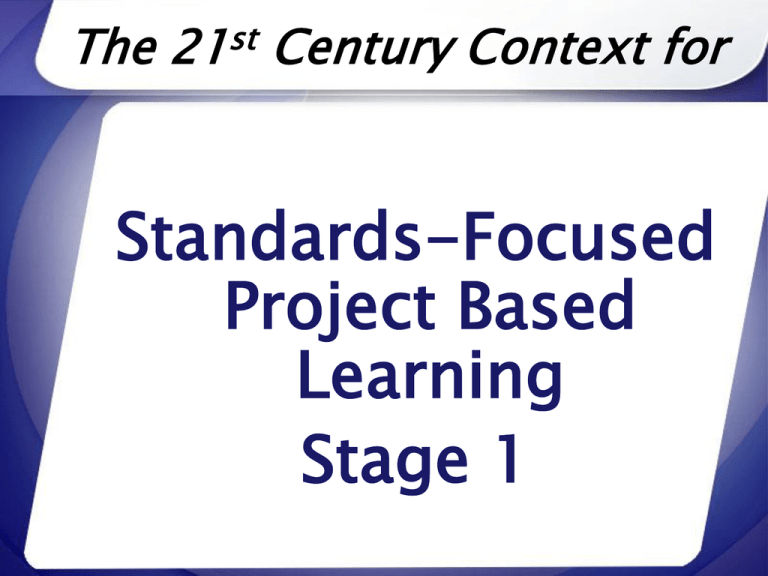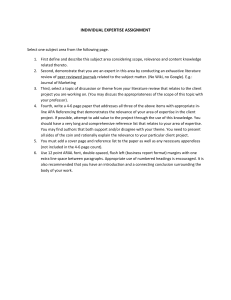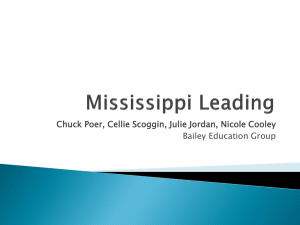Standards-Focused Project Based Learning Stage 1
advertisement

The 21st Century Context for Standards-Focused Project Based Learning Stage 1 The Rigor/Relevance Framework K N O W L E D G E T Evaluation 6 C A Synthesis 5 Assimilation X O Analysis 4 N Application 3 O M Understanding 2 A Y Awareness 1 Acquisition 1 Knowledge D Adaptation B Application 2 Apply in discipline APPLICATION MODEL 3 Apply across disciplines International Center for Leadership in Education Carla Williamson 4 Apply to real world predictable situations 5 Apply to realworld unpredictable situations 2 Rigor/Relevance Framework Teacher/Student Roles C R I G O R D Student Think High A Low Student Think & Work B Teacher Work Low Relevance Student Work High What Zone Am I In? Too Easy •I get it right away… •I already know how… •This is a cinch… •I’m sure to make an A.., •I’m coasting… •I feel relaxed,,, •I’m bored… •No big effort necessary. THIS is the place to be. On Target •I know some things… •I have to think… •I have to work… •I have to persist… •I hit some walls… •I’m on my toes… •I have to regroup… •I feel challenged… •Effort leads to success.. Too Hard •I don’t know where to start… •I can’t figure it out… •I’m spinning my wheels… •I’m missing key skills… •I feel frustrated… •I feel angry… •This makes no sense… •Effort doesn’t pay off… THIS is the achievement zone. 21st Century Skills • Critical Thinking & Problem Solving • Creativity & Innovation • Collaboration, Teamwork & Leadership • Cross-cultural Understanding • Communication & Media Literacy • Computing and ITC Technology • Career & Learning Self-direction st 21 Century Skills 7 C’s 1. Critical Thinking and Problem Solving 2. Creativity and Innovation 3. Collaboration, Teamwork and Leadership Component Skills 1. Research, Analysis, Synthesis, Project Management, etc. 2. New Knowledge Creation, Design Solutions, Storytelling 3. Cooperation, Compromise, Consensus, Community Building st 21 Century Skills 7 C’s Component Skills 4. Cross Cultural Understandings 4. Diverse ethnic, knowledge and organizational cultures 5. Communication and Media Literacy 5. Crafting and analyzing messages, using technology effectively 6. Computing and ITC Literacy 6. Effective use of electronic information and knowledge tools 21st Century Skills 7 C’s 7. Career and Learning Self Direction Component Skills 7. Managing change, lifelong learning, and career redefinition Creating a Learning Environment for 21st Century Skills Students working in teams to experience and explore relevant, real-world problems, questions, issues, and challenges; then creating presentations and products to share what they have learned. In a project learning classroom The teacher’s role is one of coach, facilitator, guide, advisor, mentor… not directing and managing all student work. Rigor/Relevance Framework Step 1. C R I G O R D High A Teacher gives students a realworld question to answer or problem to solve. B Low Low Relevance High Rigor/Relevance Framework Step 2. R I G O R C D A Students seek B High Low information to answer question or solve problem. Low Relevance High Rigor/Relevance Framework Step3. C R I G O R D High A B Low Low Relevance Students test the relevancy of the information as it relates to the question or problem. High Rigor/Relevance Framework Step 4. reflect C Students on the potential R I G O R High D use of the new information as a solution A B Low Low Relevance High Rigor/Relevance Framework Step 5. C R I G O R D Students apply the information learned to answer the question or to solve the problem. High A B Low Low Relevance High Rigor/Relevance Framework Relationships C R I G O R High D Relationships Important A Low Relationships Essential B Relationships of little importance Low Relevance Relationships Important High Begin with the end in mind. Stage 1 Stage 1- This Work Session Backward Design Process • Begin with the End in Mind – – – – – – Develop a project idea Decide the scope of the project Select standards Incorporate simultaneous outcomes Work from project design criteria Create the optimal learning environment • Craft the Driving Question Stage 2. Backward Design Process • Plan the assessment • Create a balanced assessment plan – Align products and outcomes – Know what to assess – Use rubrics Stage 3 Backward Design Process • Map the Project – Organize tasks and activities – Decide how to launch the project – Gather resources – Draw a “Storyboard” • Manage the Process – Share project goals with students – Use problem-solving tools – Use checkpoints and milestones – Plan for evaluation and reflection Step 1. Develop a Project Idea 7 Suggestions: 1. Work backward from a topic. 2. Use your standards. 3. Find projects and ideas on the Web. www.bie.org 4. Map your community 5. Match what people do in their daily work. 6. Tie the project to local and national events. 7. Focus on community service. Step 1. Develop a Project Idea 7 Suggestions: 1. Work backward from a topic. 2. Use your standards. 3. Find projects and ideas on the Web. www.bie.org 4. Map your community 5. Match what people do in their daily work. 6. Tie the project to local and national events. 7. Focus on community service. Step 2. Define scope of project. • Duration • Breadth • Technology • Outreach • Partnership • Audience 3. Select Standards What do you want your students to know and be able to do? Identify the key standards that you believe might best be met through project based instruction. No more than 3 standards per subject is best in shorter projects. Adjust accordingly for interdisciplinary or longer-term projects. Include at least one literacy outcome in your project. Do not plan for outcomes you cannot assess. Be clear about the standards that will be assessed and how the products will allow each student to demonstrate their learning. 4. Simultaneous Outcomes • Teachers incorporate more than academic outcomes into classroom activities – Specific skills (being able to work in groups, manage projects, meet deadlines, present information, think critically, solve problems, use technology efficiently) – Habits of mind (curiosity, flexibility, perseverance) SIMULTANEOUS OUTCOMES ACTIVITIES CONTENT PROCESSES HABITS OF MIND LIFELONG LEARNER Adapted from the work of Art Costa and Bena Kallick 5. Project Design Criteria The Six A’s • Authenticity • Academic Rigor • Applied Learning • Active Exploration • Adult Connections • Thoughtful Assessment Practices 5. Project Design Does the project • • • • • • • • • Meet standards? Engage students? Focus on essential understanding? Encourage higher-level thinking? Teach literacy and reinforce basic skills? Allow all students to succeed? Use clear, precise assessments? Require the sensible use of technology? Address authentic issues? Caution Well-designed projects that meet PBL criteria differ from activities, or even projects, that have been traditional in the classroom. pbl vs. projects Projects PBL Teacher directed Inquiry based Highly structured Open-ended Summative On-going Thematic Driving question/challenge Fun Engaging Answer giving Problem solving De-contextualized – School world Contextualized – Real world Continuum of Practice 6. Optimal Learning Environment • Give your project one or more connections beyond the classroom walls (partnerships, electronic linkages with distant people, mentorships) • Alter the look and feel of your classroom (partition room for group spaces; make the classroom like an office or laboratory) 6. Optimal Learning Environment Three Ideas for improving learning: See the whole before practicing the parts. Study content and apply it to authentic problems. Make schoolwork more like real work. Buck Institute PBL Handbook Begin with the End in Mind Idea Bank Project Ideas Project Outcomes Project Design Crafting the Driving Question When crafting the Driving Question, remember: Driving Questions are provocative. Driving Questions are open-ended. Driving Questions go to the heart of a discipline or topic. Driving Questions are challenging. Driving Questions can arise from realworld dilemmas that students interesting. Driving Questions are consistent with curricular standards and frameworks. Example from PBL Handbook Should the Unites States have used the atomic bomb in World War II? Resources Project Planning Forms Buck Institute PBL Handbook “Begin with the End in Mind” & “Draft the Driving Question”




